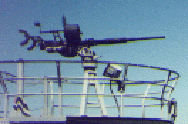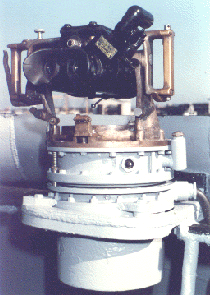Replacement of Missing EquipmentReplacing equipment on WW II submarines is indeed a challenge. By the time Pampanito was opened to the public in 1982 most of the wartime submarine fleet had been sold to foreign navies, sunk as targets or scrapped. USS Roncador, failed to become an exhibit in Long Beach and was scrapped in 1983. The Navy allowed historic submarine operators to remove needed items before she was transferred to the scrapper. This opportunity was our first chance to replace some of the missing items. Among the items removed for installation on Pampanito were the high pressure air manifold, dead reckoning analyzer indicator, dive plane and helm operating wheels, one of the two dead reckoning tracers, compartment bill holders, gyrocompass repeaters, a deep depth gauge, two torpedo skids and several other items. The Navy took the conning tower from Roncador for eventual restoration and display in the Washington Navy Yard. In 1998 they offered the conning tower to the Maritime Park Association and we now have it in storage waiting for restoration and display in our museum. Many smaller items are on loan from the Navy including a rare Mark 18 torpedo. Equipment was also removed from USS Blenny (SS-324) before she was sunk as an artificial reef off the coast of Maryland, USS Turbot (SS-427) before she was scrapped and USS Sailfish (SS-572) before sinking.
In 1982 we also obtained an inappropriate main deck gun (that was considered to be better than no main deck gun) until the closer weapon was found in a Los Angelos tank museum. Bob Morin, the director of Silversides, knew we were still looking for the proper main deck gun and knew USS Tautog, one of the highest scoring submarines of WW II, had been scrapped in Manistee, a few miles north of him. With his help, and the help of John Bultima, a WW II subvet who had scrapped the submarine, Tautog's four-inch 50 was restored and was displayed on Pampanito's main deck for many years. Then it was traded with the Submarine Force Museum in Groton, CT for a 5" 25 cal wet mount gun similar to the last gun mounted on Pampanito in summer 1945. In the process of locating the first 40mm gun we established a relationship with the Navy Historical Center's Curator Branch, then under the direction of Henry Vadnais. A Pampanito veteran, Leroy Van Housen, had spotted a single barreled 40mm sitting in a storage yard near his home in Virginia. Through the Historical Center we obtained the gun on long term loan and have restored the weapon and installed it on the cigarette deck. We have continued to rely on the Center's Curatorial Branch, for their assistance in locating items on our wish list. Finally, after searching for a second decent quality Bofors 40mm gun for 30 years we found two miserable condition guns and built the second Bofors we needed. In 2021 we moved the brow aft, rebuilt the 5-inch gun foundation aft, moved the five inch gun aft, and place the second Bofors on the conning tower. We finally have all the big pieces needed to restore the boat summer of 1945 configuration.
Through our participation in the Historic Naval Ships Association (HNSA), an association of museum ships, we have developed a network of historic ship museums that share the goal of restoring their vessels. Alabama, Bowfin, Cobia, Cod, Croaker, Drum, Kidd, Ling, Lionfish, Requin, Silversides, and Torsk have all collaborated in big ways to help the restoration of Pampanito. Through them we have been able to replace the pressure proof speaker on the bridge, the valves in #1 main air compressor, 40mm sites, pelorus (TBT) binoculars, torpedo skids, bunks, depth gauges, and smaller items like dishware and linens. Private collectors, have continually donated needed equipment, as well as memorabilia. For example the sewing machine. Whether it is a long held souvenir, or a piece of equipment found at a flea market or surplus store, or something found on Ebay, we have been fortunate to have had several significant donations. Members of Pampanito's wartime crew have donated many personal items like photographs, the original hand painted battle flag, a pocket Bible carried on all six war patrols, artwork and much more. Other items have been donated from corporations and small companies such as a master gyrocompass amplifier, teak wood for the main deck, Mark 14 torpedoes, a torpedo gyro, radio equipment, pendulous clinometer heel indicator, and technical manuals. Occasionally we have bought or bartered with commercial scrap yards, eBay and other for profit entities. Since we can rarely afford the fair market value, we have been fortunate to often find that we are given severely discounted prices. The ice cream freezer, BN and ABK IFF gear, RBH-2, SCR-624, barometers/manometers and others. We have very little replica on the boat, but we have replicated some bunk frames, torpedo skids, emergency escape ascending line reels, galley and crew's mess equipment, fuse tester bars, wardroom bookcase, cigarette but cans, running light covers, and other smaller items when we could not find originals. We always document these, use similar materials and methods of construction, and continue to look for the real materials to replace the replicas. Replicating even small items can be a quite involved process, see the clinometer story, or the magnetic compass. Some projects, like the depth gauge restoration have been a mix of donated, bought and replicated materials. Our restoration goal to make the submarine complete also includes things that the visitors will never see. The forward torpedo impulse flasks were missing from their mountings under the main deck. The full set of six large high pressure air flasks was located aboard USS Turbot in Maryland, and were a perfect match to the originals. They were removed, trucked to San Francisco and installed. We, of course, have no plans to ever fire torpedoes. However, the primary weapon of a WW II submarine was the torpedo and the system that delivered them should be complete. We are very thankful to the many individuals, companies and government agencies that have helped us replace the missing equipment. We have a Wish List of parts and equipment that we are seeking for ongoing restoration.
|

 The
replacement of the topside guns is a good example of how things came together.
An incomplete 20mm gun came from a federal agency, the shoulder
rests and magazine came from the Jeremiah O'Brien, the sight from
a private collector. A mount for the weapon was jury rigged from a older
bell type mount and an incomplete tripod mount. This arrangement was adequate
until the proper mount could be obtained from USS Silversides several years later. Fifteen years later a single mount was traded for a twin mount with PT Boats Inc., a second gun was donated from a local collector. We finally had the parts for a
The
replacement of the topside guns is a good example of how things came together.
An incomplete 20mm gun came from a federal agency, the shoulder
rests and magazine came from the Jeremiah O'Brien, the sight from
a private collector. A mount for the weapon was jury rigged from a older
bell type mount and an incomplete tripod mount. This arrangement was adequate
until the proper mount could be obtained from USS Silversides several years later. Fifteen years later a single mount was traded for a twin mount with PT Boats Inc., a second gun was donated from a local collector. We finally had the parts for a  Another
source that continually provides needed equipment is WW II vintage surface
ships slated for disposal by the Navy or the Maritime Administration. Much
of the equipment aboard these ships is common to all vessels of the era,
such as electronic equipment, washing machine, galley and mess items, switches and gauges, pumps, etc. We even found a TDC Mk IV on one of the ships waiting to be scrapped and where able to save it for shoreside display.
Another
source that continually provides needed equipment is WW II vintage surface
ships slated for disposal by the Navy or the Maritime Administration. Much
of the equipment aboard these ships is common to all vessels of the era,
such as electronic equipment, washing machine, galley and mess items, switches and gauges, pumps, etc. We even found a TDC Mk IV on one of the ships waiting to be scrapped and where able to save it for shoreside display.